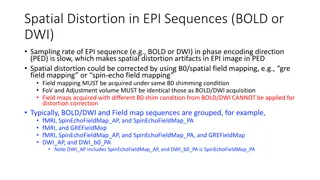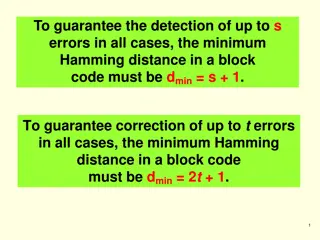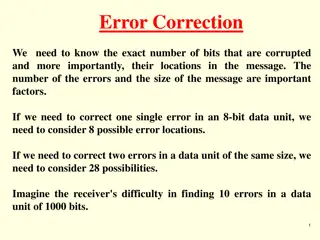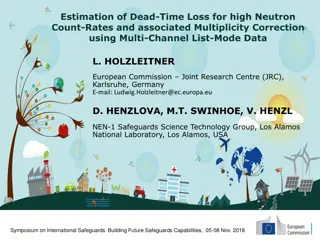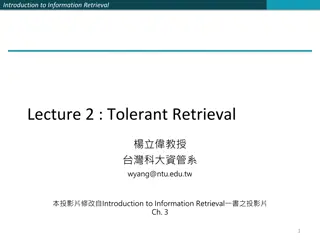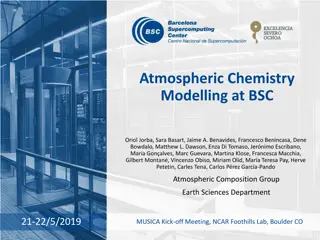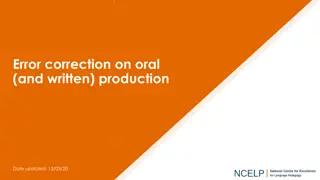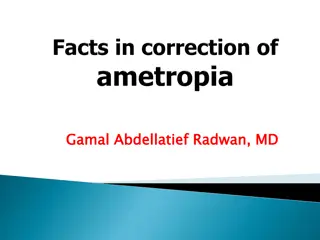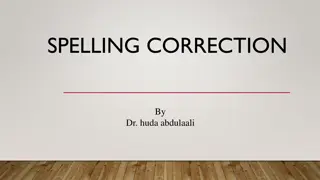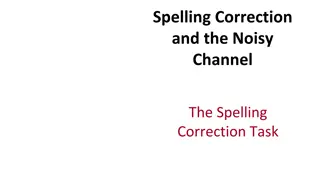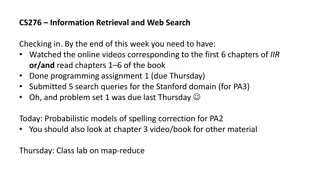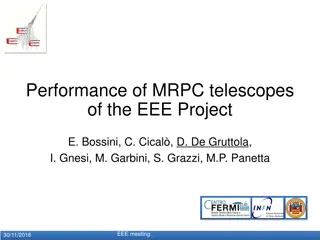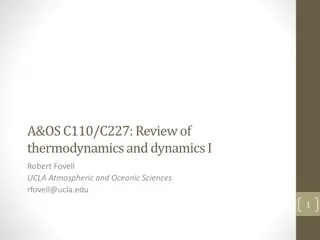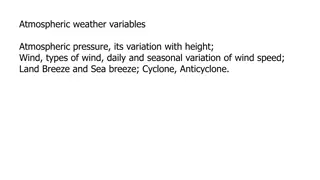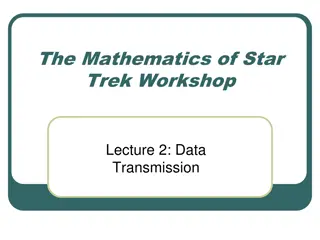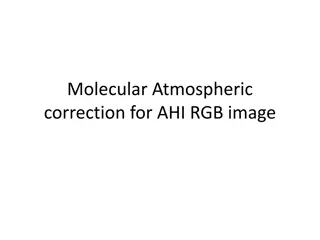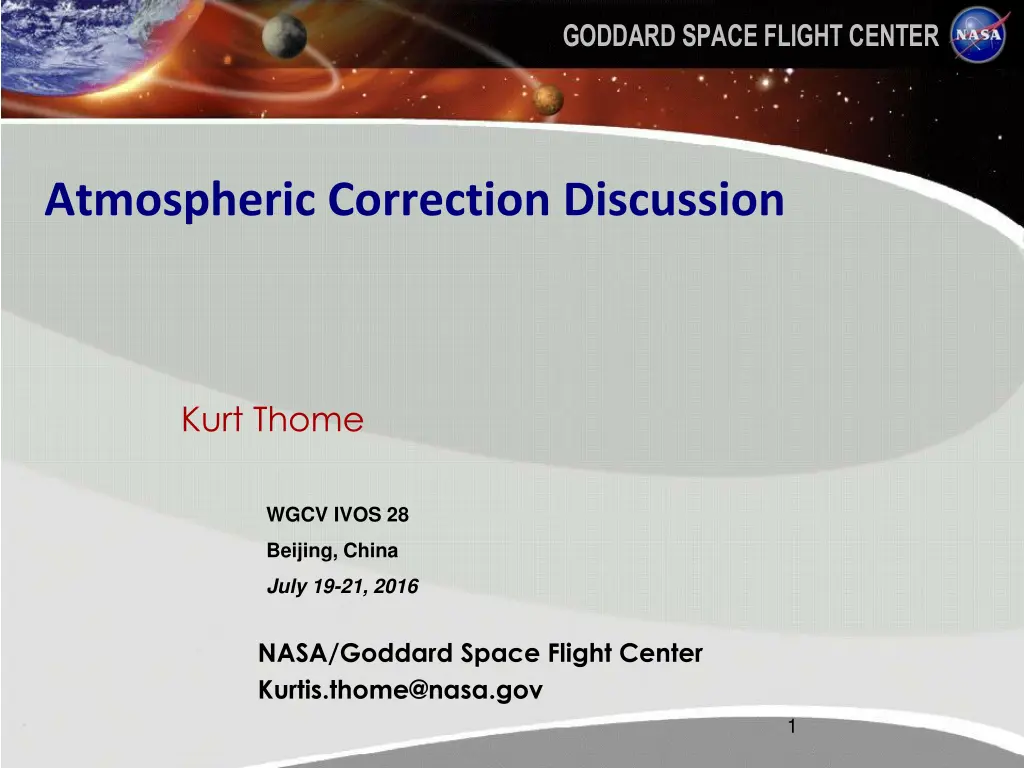
Atmospheric Correction Discussion and Leveraging RadCalNet Work
Explore the impact of uncertainties in atmospheric corrections through the discussion on vicarious calibration. The focus is on developing recommended approaches for better comparability among different groups, ensuring new method development, and establishing common starting points. Leveraging RadCalNet involves creating base cases and sensitivity analyses, leading to the compilation of best practices and guidance for newer users in atmospheric parameterization and measurement approaches.
Download Presentation

Please find below an Image/Link to download the presentation.
The content on the website is provided AS IS for your information and personal use only. It may not be sold, licensed, or shared on other websites without obtaining consent from the author. If you encounter any issues during the download, it is possible that the publisher has removed the file from their server.
You are allowed to download the files provided on this website for personal or commercial use, subject to the condition that they are used lawfully. All files are the property of their respective owners.
The content on the website is provided AS IS for your information and personal use only. It may not be sold, licensed, or shared on other websites without obtaining consent from the author.
E N D
Presentation Transcript
GODDARD SPACE FLIGHT CENTER Atmospheric Correction Discussion Kurt Thome WGCV IVOS 28 Beijing, China July 19-21, 2016 NASA/Goddard Space Flight Center Kurtis.thome@nasa.gov 1
Reminder Ultimate goal of atmospheric correction discussion is understanding the impact of uncertainties in the correction Concentrated on impacts to vicarious calibration Develop a set of recommended approaches to ensure better comparability between different groups Permit development of new methods Create a common starting point for all groups Areas for best practices are Radiative transfer code Input parameterization Measurement approaches Instrumentation Retrieval methods
Leveraging RadCalNet work Will create a base case using the same MODTRAN version and parameterization as used for RadCalNet No aerosol absorption highlights impact of aerosol composition selection Modest aerosol loading (0.2 at 550 nm) Spectral reflectance constant with wavelength Base case input of 0.4 reflectance Second case with 0.05 reflectance 45 degree view angle (no ambiguity on elevation versus zenith) 60-degree solar zenith angle (large difference in radiance if elevation versus zenith angle confusion) Lambertian surface TOA reflectance output at 1-nm intervals from 400 to 2500 nm
Atmospheric parameterization List of parameters that will be reported include consistently derived multiple formats Spectral optical depth (total, component) Aerosol optical depth at 550 nm = 0.20 Angstrom coefficient (also known as power law exponent) = 1.00 Junge parameter = 3.00 Surface pressure = 1013 mb Column water vapor amount = 2.54 cm Column ozone amount = 280 Dobsons Clean Maritime aerosol type Real index 1.39 Imaginary index 0.0 View-sun geometry View zenith 45 degrees Solar zenith 60 degrees Delta azimuth 90 degrees Surface height 0 km Sensor height - >100 km
Summary Data set generation has taken place and we are using RadCalNet work to develop multiple output sets Attempting to pre-determine likely questions Work is being combined with RadCalNet efforts Document radiative transfer code uncertainties Help develop answers to questions from newer users Will generate a sensitivity analysis example Helps with RadCalNet uncertainty development Provide guidance to newer users Further outcomes Compiling results leads to a set of best practices Processing schemes Input parameterization Recommended measurement approaches
Coupling with Atmospheric Correction Task Group WGCV is implementing an Atmospheric Correction Task Group More on task groups in later IVOS talk Recall the IVOS atmospheric correction activity is primarily interested in impact of atmospheric correction in vicarious calibration Use of radiative transfer codes Measurement approaches to assess atmospheric parameters Atmospheric Correction Task is evaluating impacts of atmospheric correction on user products Cross cutting the Land Product Validation, Atmospheric, and IVOS sub groups Interaction with other CEOS non-CEOS entities Lessons learned from the Task Group will feed back into the IVOS activity (and vice versa)
ACIX Atmospheric Correction Inter-comparison eXercise Georgia Doxani | Serco for ESA/ESRIN, Georgia.Doxani@esa.int Ferran Gascon | ESA/ESRIN, Ferran.Gascon@esa.int Jean-Claude Roger | University of Maryland, roger63@umd.edu ric Vermote | NASA, eric.f.vermote@nasa.gov
- What? International collaborative initiative to inter-compare a set of atmospheric correction (AC) processors for high- spatial resolution optical sensors Focus on Landsat-8 and Sentinel-2 imagery Better understanding of the different uncertainty contributors and help in improving the AC processors
- When? IMPORTANTDATES 1st Workshop Announcement 25 January 2016 1stWorkshop Registration Deadline 15 March 2016 1st Workshop Preliminary programme 30 April 2016 Proposals for AC inter-comparison protocol Deadline 31 May 2016 1st Workshop of CEOS-WGCV Atmospheric Correction Inter-comparison Exercise 21-22 June 2016 Results Submission Deadline 15 October 2016 Results Analysis Report 15 December 2016 2nd Workshop of CEOS-WGCV Atmospheric Correction Inter-comparison Exercise 1stquarter of 2017
- Who? 14 atmospheric correction processors 15 organisations, institutes, universities, companies 5 countries: Australia, Belgium, France, Germany, USA
- Where? 1st ACIX workshop (21-22 June 2016) venue: College Park Marriott Hotel & Conference Center 2ndACIX workshop venue: At ESRIN during 1stquater 2017
- Outcomes of the 1st workshop Definition of the protocol and procedures for inter- comparing products Definition of test regions and time periods for quality assessment Description of a coordinated plan for inter-comparison activities
What should be included in atmospheric correction ? >> Mandatory run: Rayleigh and aerosol scattering gas absorption adjacency effects (if it cannot be turned off) >> Optional run: Including any other correction, e.g.: BRDF correction adjacency effects topography effects sun glint effects (over water-surface) cirrus/haze correction Sample results will be submitted by 15/7/2016
AERONET station TEST SITES Zone Land Cover lon, lat Frioul [France] MidlatitudeN 5.293, 43.266 vegetated, bare soil, coastal Boreal forest, snow, agriculture 9.844, 46.813 Davos [Switzerland] Beijing [China] MidlatitudeN urban, mountains 116.381, 39.977 Temperate Canberra [Australia] MidlatitudeS urban, vegetated, water 149.111, -35.271 urban, semi-arid 28.280, -25.757 Pretoria_CSIR-DPSS [South Africa] SubTropicalS Sioux_Falls [USA] MidlatitudeN cropland, vegetated -96.626, 43.736 urban, forest, cropland, water GSFC [USA] MidlatitudeN -76.840, 38.992 forest, river, snow 129.367, 61.662 Yakutsk [Russia] Polar desert, cropland 2.665, 13.541 Banizoumbou [Niger] Tropical Arid desert, ocean -22.935, 16.733 Capo_Verde [ Capo Verde] SubTropicalN desert 34.782, 30.855 SEDE_BOKER [Israel] MidlatitudeN Equatorial Boreal cropland, urban, forest -56.104, -9.871 Alta_Floresta [Brazil] Tropical Forest cropland, urban, forest 124.843, 6.496 ND_Marbel_Univ [Philippines] Tropical semi-arid -116.992, 46.487 Rimrock [USA] Boreal 2.955, 51.532 Boreal Thornton C-power (Belgium) water, vegetated Coastal Sites 29.360, 44.600 MidlatitudeN water, vegetated Gloria [Romania] 10.606, 45.500 Boreal water, vegetated , urban Sirmione_Museo_GC (Italy) 12.508, 45.314 Boreal water, vegetated , urban Venice (Italy) WaveCIS (USA)???
- Aerosol Validation Comparison between resulted AOT & Level 1.5 (cloud screened) AERONET data 1. Interpolate AERONET values @ =550 nm using the Angstrom Exponent 2. Average AERONET values over time period of 30min from AOT retrieved values (image acquisition time) 3. Average AOT values over an image subset of 9 km x 9 km centred on the AERONET Sunphotometer station Visualization of Inter-comparison Results Scatter plots per date and method Time series plots of the submitted AOT values (y axis) against AERONET (x axis)
- Inter-comparison of the BOA products >> Visualization of Inter-comparison Results Histograms per date, band and AC approach Profile plots across the images per date, band and AC approach Time series plots of the estimated Surface Reflectance >> NDVI calculation and comparison: indicator for relative inter-band differences Quantification of Inter-comparison Results >> Distance matrix N x N >> N = AC processors, d = normalized distances between the resulting BOA values of a 9 km x 9 km subset averaged over the available dates AC Processor 1 AC Processor 2 AC Processor 3 AC Processor n AC Processor 1 0 d12 d13 d1n AC Processor 2 d21 0 d23 d21 AC Processor 3 d31 dn1 d21 dn2 0 d3n 0 . dn3 AC Processor n
- Comparison with AERONET corrected data Atmospherically corrected data will be generated by a radiative transfer model, like libRadtran or 6S, using AERONET data >> Pixel-by-pixel comparison between each of the spectral bands and the corresponding AERONET corrected surface reflectance data will be done for all the 9 km 9 km subsets >> >> Only the non-saturated, non-cloudy and non-missing pixels will be considered in the comparison (Quality flags will be provided by the participants)
- Comparison with MODIS (MOD09CMG) daily SR products >> Pixel-by-pixel comparison between each of the spectral bands and the corresponding most similar MODIS band. Due to the different satellite orbits, the direct comparison of the SR could deliver misleading results. Therefore, the adjustment of distribution function to the corresponding Landsat-8 and Sentinel-2 sun and view geometry is required. MODIS bidirectional reflectance >> Same metrics as before (residuals, accuracy, uncertainty, etc.)



